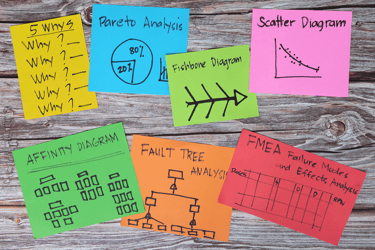The Packaging Industry's Sustainability Challenge: Why ERP Systems Are Essential for Success A straightforward guide to navigating sustainability regulations across folding carton, flexible...
10 flexible packaging industry trends to watch in 2025 & beyond
A recent report by artizon predicts the global flexible packaging market will be valued at almost USD 400 billion by 2029.
The rise in popularity of flexible packaging is unsurprising, given it offers brands and retailers a cost-effective, convenient, and sustainable way to promote and package their products.
But what are the trends that shape this growth market in 2025 and beyond?
Contents
What is flexible packaging?
Flexible packaging refers to a package or part of a package whose shape can be readily changed when filled or during use. Typically, this includes bags, pouches, liners, wraps, and roll stock.
Flexible package materials typically consist of paper, plastic, film, aluminum foil, or combinations of those materials.
What trends are we likely to see?
The trends below highlight just some of the ongoing evolution within the flexible packaging industry towards more sustainable, innovative, and consumer-centric solutions. The main drivers are technological advancements, market dynamics, and changing consumer preferences.
1. Sustainability
The world produces an estimated 141 million tonnes of plastic packaging a year, and consumers and regulators are increasingly focusing on reducing the climate impact of this plastic and, consequently, the other packaging materials used to manufacture flexible packaging.
While flexible packaging is a plastic product, it weighs a fraction of rigid plastic containers or glass. As such, it requires less transport cost and associated CO2 emissions due to its volume and weight, not to mention occupying less space in landfills if that's where it ends up (which in turn reduces the carbon footprint).
Recent advances have made completely biodegradable bio-resins available to brands. The major limitation of bio-resins is their cost. However, once adoption becomes widespread and volumes increase, the price will reduce.
The circular economy is further driving innovations that improve the overall sustainability of the products sold within flexible packages, but this can be a complicated tightrope for flexible packaging manufacturers to navigate.
Smart packaging
Radio-frequency IDentification (RFID) tags and NFC (Near Field Communication) have been adopted in retail and transportation logistics for some time already, as they are inexpensive and provide consumers with traceability through the supply chain.
Food waste and safety concerns coupled with new traceability rules from the U.S. Food and Drug Administration are expected to further accelerate the adoption of RFID and NFC within packaging.
Smart packaging also enables consumers to access detailed information on the product, such as the sourcing of raw materials, production processes, and environmental impact.
2. Convenience and portability
We lead increasingly busy lives, and this is reflected in the growing demand for flexible packaging formats such as stand-up pouches, sachets, and resealable bags.
This is also driving innovations for more convenient and portable flexible packaging, such as Bostik’s Reseal™ technology, resale labels, and fitment & stand-up pouches. This is a complex landscape considering the demands for both more complex and simultaneously more sustainable flexible packaging formats.
3. eCommerce
It is anticipated that eCommerce sales could reach 23% of all global retail sales by 2027, this is already impacting the packaging protecting these products sold online.
This increases the remit on flexible packaging. It must be lightweight to limit carbon emissions during transit, protect the product, and provide tamper-evident seals, all whilst providing packaging that becomes inseparable from the overall brand and customer experience.
4. Regulatory compliance
Several factors are driving the evolving landscape of regulatory requirements for flexible packaging manufacturers; including food safety, product labeling, and environmental stewardship.
As such investments are being made in technologies and processes to ensure compliance with industry and government regulations to ensure compliance and mitigate risks.
Legislation implemented by Governments in response to macro-environmental factors is giving rise to an increasingly complex legislative environment. The Plastic Packaging Tax enforced by the UK Government is but one example of this in action.
5. Transparency and traceability
Consumers (and therefore brands) are demanding greater transparency and traceability throughout the supply chain. In response to this, brands are incorporating QR codes, blockchain technology, and other digital solutions to provide detailed product information, origin tracking, and sustainability certifications.
6. Digital printing
Digital printing technologies have advanced in recent years to offer improved print quality, faster turnaround times, and cost-effective customization vs more traditional methods, such as Offset Lithography Printing.
Brands are leveraging digital printing for shorter print runs, versioning, and personalized packaging to enhance consumer engagement.
7. Anti-counterfeiting measure
Counterfeiting and product tampering remain significant challenges, particularly within the pharmaceutical and food industries. Advancements in technologies such as holographic films, security inks, and tamper-evident seals are being adopted to deter counterfeiters and protect brand integrity.
8. Reduction of food spoilage and increased food safety with multi-layer films
To meet the requirements for extended shelf life and product freshness, multi-layer films with enhanced barrier properties are increasing in demand. Innovations in barrier coatings, high-performance resins, and active packaging technologies are enabling flexible packaging to preserve product quality and extend shelf life.
Extensive research has proven that these cutting-edge barrier technologies and film formulations have saved billions in spoiled foods, not to mention greatly enhanced food safety.
9. Mergers and acquisitions
Packaging Gateway reported that during Q3 of 2023, there were 33 M&A deals announced within the global paper & packaging industry, these were worth a total value of USD 1.4bn.
This is a trend set to continue; Mordor Intelligence predicts the packaging market overall is estimated to be worth USD 1.14 trillion in 2024, and is expected to reach USD 1.38 trillion by 2029.
With high barriers to entry for new players into the industry, mergers and acquisitions are likely to see an increasingly consolidated landscape with large players emerging.
M&A in the global paper & packaging industry (by deal value) - Q3 2021 - Q4 2023
10. Bridging CAPEX and OPEX with Smart Software Investments
As packaging manufacturers face the dual challenge of aging equipment and tightening budgets, the traditional CAPEX-heavy approach to tech upgrades is shifting. More companies are adopting software-driven solutions that deliver operational improvements without the need for massive capital expenditures.
This trend reflects a broader move toward OPEX-friendly investments, where software platforms enhance the performance of existing machinery, extend asset life, and reduce unplanned downtime.
Manufacturers are increasingly leveraging cloud-based applications, MES platforms, to modernize their operations incrementally. This approach enables flexible packaging businesses to stay competitive, agile, and efficient - without the financial strain of full equipment overhauls.
In 2025 and beyond, expect to see more companies bridging the CAPEX-OPEX divide through intelligent, scalable software solutions.
How ePS Packaging can help
Our software solutions are built specifically to the needs of the packaging industry and the flexible packaging trends that define it. We provide our customers with an end-to-end management platform, covering everything from estimating and production planning to inventory management and sophisticated supply chain coordination.
But the real demonstration of what we achieve lies in the results that we deliver for our customers, discover how we have helped some of the leading companies within the flexible packaging industry to keep ahead of flexible packaging market trends.





